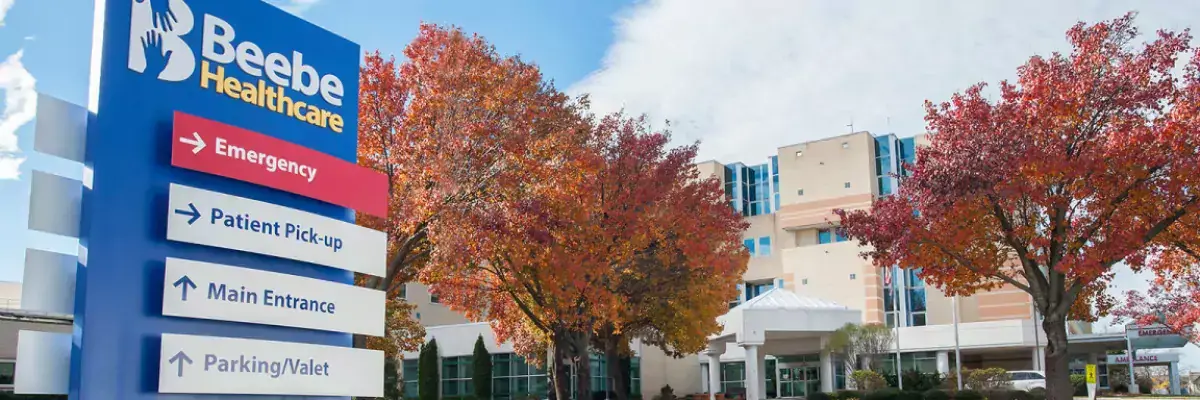Lumpectomy: What Can I Expect?
One surgical option for breast cancer is a lumpectomy. If you are scheduled for a breast lumpectomy, you likely have questions about the procedure and what recovery is like. We’ve included some answers to common questions patients have about breast lumpectomy. We also encourage you to talk to your oncologist and care team about your concerns.
Beebe Healthcare's oncology team is here for you every step of the way.
What is a lumpectomy?
A lumpectomy is the surgical removal of a breast mass and not the whole breast. Your provider may recommend a lumpectomy if cancer affects one area of your breast, or the tumor is small in comparison to your breast size. It can help treat early stage breast cancer.
During a lumpectomy, a surgical oncologist will remove the mass and a small area of surrounding normal breast tissue. The borders of the tissue removed are called surgical margins. If cancer is found, these “margins” should not contain any cancer. This reduces the risk of cancer growing back in that breast.
If the lab report or pathology report says that cancer is seen at or close to the surgical margin, more surgery may be needed to obtain "clear margins."
Is a lumpectomy an outpatient procedure?
In most cases a lumpectomy is done as an outpatient or same day surgery. Many patients go home the same day or have a short hospital stay.
What is recovery after lumpectomy like?
Your surgeon will talk to you about specific recovery issues. After surgery, you could have any of the following issues, which will resolve over time:
- Pain, swelling, or sensitivity at surgical site
- Bruising
- Lump or firmness at the surgical site
Recovery time can vary for each patient. In general, you will be up and moving the day after surgery. You will have some limitations to your normal schedule and exercise routine in the first week or so. Complete recovery from a lumpectomy may take up to a month.
Can I prevent infections?
It is not common that patients get an infection of the surgical site after a lumpectomy. You can prevent an infection by:
- Taking a shower the night before surgery and wash your body with soap and water.
- Do not immerse the incision site in water (soaking in a tub or swimming).
- Always wash your hands before and after touching the incision or changing the dressing.
What will I need at home?
- A supportive, cotton bra or sports bra to wear the days and weeks after surgery.
- Gauze pads (4x4) to place inside your bra for comfort and protection (no need to use any tape). Gauze pads can be found at your supermarket or pharmacy.
- Clean, supportive pillow(s) to put under your arm while sitting or to help with positioning at night.
- You may have constipation after surgery. Over-the-counter medications, adding fiber to your diet, exercise (as simple as walking) and fluids may ease constipation. Ask your healthcare team about over-the-counter medications that may work for you.
General Care After Lumpectomy
If you have a post-surgical bandage, remove per your surgeon's instructions (often within 48 hours). Once the bandage is removed, you may shower, but do not scrub the incision. To dry, carefully pat the incision with a clean towel. Avoid lotions, powders or deodorant on or near the incision during the first 1-2 weeks until it is fully closed.
Most surgeons use dissolvable sutures inside your body which will go away on their own. On the outside, your surgeon may use surgical glue, paper tape called "steri-strips" or nothing at all. Both glue and steri-strips can get wet in the shower.
How can I care for myself?
You will want to have a family member or friend come with you the day of surgery. Following surgery, you may want this person to stay with you for up to 48 hours until you are able to complete your daily tasks and feel better. It may take some time before your team tells you that it is ok to go back to your normal activity. Allow yourself to rest and lean on your support network, especially in the first few days.
Symptom management, including pain, is another important part of recovery. Constipation is a common symptom after surgery. There are ways to manage constipation after your surgery. You can change your diet, drink more fluids, and take over-the-counter medications. Talk with your care team before taking any medications for constipation. Be sure to take your prescribed medications as directed to prevent pain, infection, or constipation. Call your team with any new or worsening symptoms.
Taking deep breaths and resting can help manage pain, keep your lungs healthy after anesthesia, and promote good drainage of lymphatic fluid. Try to do deep breathing and relaxation exercises a few times a day in the first week, or when you notice you are extra tense. For example, while sitting, close your eyes and take 5-10 slow deep breaths. Relax your muscles. Slowly roll your head and shoulders.
This article contains general information. Please be sure to talk to your care team about your specific plan and recovery. Contact your provider if you are experiencing new or worsening symptoms following your lumpectomy.
Learn more about Beebe’s Breast Health program, which provides surgical and non-surgical treatment for individuals with breast cancer and other breast conditions. Led by board certified surgeon Dr. Diana Dickson-Witmer, our certified and experienced surgical oncology team is here for you.
References and Sources:
American Cancer Society. Breast-Conserving Surgery. 2019. Found at https://www.cancer.org/cancer/breast-cancer/treatment/surgery-for-breast-cancer/breast-conserving-surgery-lumpectomy.html
MedLine Plus. Breast lump removal. 2018. Found at https://medlineplus.gov/ency/article/002918.htm
The American Society of Breast Surgeons. Performance and practice guidelines for breast-conserving surgery/partial mastectomy. Found at www.breastsurgeons.org/docs/statements/Performance-and-Practice-Guidelines-for-Breast-Conserving-Surgery-Partial-Mastectomy.pdf



